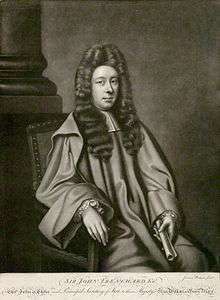John Trenchard (politician)
| Sir John Trenchard | |
|---|---|

| |
| Secretary of State for the Northern Department | |
|
In office 1693–1694 | |
| Preceded by | The Earl of Nottingham |
| Succeeded by | The Duke of Shrewsbury |
| Personal details | |
| Born |
30 March 1649 Lytchett Matravers, Dorset |
| Died |
27 April 1695 (aged 46) Kensington, London |
| Resting place | Bloxworth, Dorset |
Sir John Trenchard (30 March 1649 – 27 April 1695)[1] was an English politician and landowner.
Life
He belonged to an old Dorset family. He was born on 30 March 1649 at Lytchett Matravers, near Poole, to Thomas Trenchard of Wolverton (1615–1671), and his wife Hannah née Henley (d. 1691).[1] His grandfather was Sir Thomas Trenchard of Wolverton (1582–1657), who was knighted by James I in 1613.[2]
He was educated at Winchester (1661-1665) and at New College, Oxford (1665-1667).[1] In 1667, he entered the Middle Temple and was called to the bar in 1674. John Trenchard entered parliament as member for Taunton in 1679. He associated himself with those who proposed to exclude the Duke of York from the throne, and attended some of the meetings held by these malcontents. It is possible he was concerned in the Rye House Plot. In fact, he was arrested at all of the events in July 1683, but no definite evidence was brought against him so he was released.[2]
When Monmouth landed in the west of England in June 1685, Trenchard fled from England to Groningen, Netherlands.[3] Around 1687-1688, he was pardoned through the good offices of William Penn, and able to return home. Again he entered parliament, but he took no active part in the Revolution of 1688, although he managed to secure the good will of William III. On 29 October 1689, he was knighted by the king, and made Chief Justice of Chester. In 1692, he was appointed Secretary of State. He and the government incurred much ridicule through their failure to prove the existence of a great Jacobite plot in Lancashire and Cheshire in which they had been led to believe.[2]
Family
On 10 November 1682, he married: Philippa Speke (1664–1743), daughter of George Speke of White Lackington, Somerset, with 4 sons and 3 daughters including:
- George Trenchard (d. 1758)
- Maria Trenchard (1687-)
- William Trenchard (12 October 1694-)
Sir John died on 27 April 1695 at Kensington, London, and is buried at Bloxworth, Dorset.
See also
Notes
- 1 2 3 "TRENCHARD, Sir John (1649-95), of Lytchett Matravers, nr. Poole, Dorset". The History of Parliament Trust. Retrieved 14 Dec 2014.
- 1 2 3 Chisholm 1911.
- ↑ IGI: Baptism of Maria Trenchard to John and Philippa on 18 Mar 1687 at Nederlands Hervormde Kerk, Groningen, Netherlands
References
 This article incorporates text from a publication now in the public domain: Chisholm, Hugh, ed. (1911). "Trenchard, Sir John". Encyclopædia Britannica. 27 (11th ed.). Cambridge University Press.
This article incorporates text from a publication now in the public domain: Chisholm, Hugh, ed. (1911). "Trenchard, Sir John". Encyclopædia Britannica. 27 (11th ed.). Cambridge University Press. Seccombe, Thomas (1899). "Trenchard, John (1640–1695)". In Lee, Sidney. Dictionary of National Biography. 57. London: Smith, Elder & Co. , which gives his year of birth incorrectly as 1640.
Seccombe, Thomas (1899). "Trenchard, John (1640–1695)". In Lee, Sidney. Dictionary of National Biography. 57. London: Smith, Elder & Co. , which gives his year of birth incorrectly as 1640.- Clifton, Robin. "Trenchard, Sir John (1649–1695)". Oxford Dictionary of National Biography (online ed.). Oxford University Press. doi:10.1093/ref:odnb/27705. (Subscription or UK public library membership required.)
| Parliament of England | ||
|---|---|---|
| Preceded by Sir William Wyndham, Bt Sir William Portman, Bt |
Member of Parliament for Taunton with Sir William Portman, Bt1679 Sir John Cutler, Bt 1679–1680 Edmund Prideaux 1680–1685 1679–1685 |
Succeeded by Sir William Portman, Bt John Sanford |
| Preceded by William Harbord Sir Francis Guybon |
Member of Parliament for Thetford with 1689–1690 |
Succeeded by Sir Francis Guybon William Harbord |
| Preceded by Henry Trenchard Sir Nathaniel Napier, Bt |
Member of Parliament for Poole with Sir Nathaniel Napier, Bt 1690–1695 |
Succeeded by Sir Nathaniel Napier, Bt Lord Ashley |
| Political offices | ||
| Preceded by The Earl of Nottingham |
Secretary of State for the Northern Department 1693–1694 |
Succeeded by The Duke of Shrewsbury |
| Secretary of State for the Southern Department 1693–1695 | ||
| Legal offices | ||
| Preceded by Sir Job Charlton |
Chief Justice of Chester 1689–1690 |
Succeeded by John Coombe |